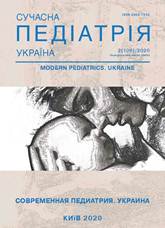Features of the course of serious meningites of herpetic ethiology
Keywords:
serous meningitis of herpetic and nonherpetic etiology, patientsAbstract
Meningitis is an acute infectious lesion of the meninges caused by bacteria, viruses, fungi, or protozoa. The etiological structure is dominated by serous meningitis. At the present stage, the most severe consequences of serous viral meningitis are associated with herpes virus damage to the central nervous system.
Aim. To identify the features of the course of serous meningitis of herpetic etiology in children and adults.
Materials and methods. The article presents a retrospective analysis of case histories of 25 patients who during 2018–2019 were treated at the Regional Regional Infectious Clinical Hospital of the Zaporizhzhya Regional State Administration for serous meningitis. All patients underwent DNA determination of herpes viruses (EBV, type 1 and type 2 HSV and CMV) using polymerase chain reaction in cerebrospinal fluid. According to the results of the examination, the patients were divided into 2 groups: I – 11 patients with meningitis of herpetic etiology; II – 15 patients with serous meningitis of unknown etiology.
Results and conclusions. 73.4% of patients of group I were hospitalized with a diagnosis of meningitis, among patients of group II 6 (40%) patients were diagnosed with acute respiratory viral infections, tonsillitis and fever of unknown etiology. Herpetic etiology of the disease was more often recorded in the older group, and in the group of serous meningitis of another etiology there were significantly more patients 10–18 years old (p=0.02). Herpetic lesion was manifested by a more expressed meningeal and focal symptoms in the onset of the disease. In a laboratory study, patients with meningitis had blood with lymphocytosis of non-herpetic etiology more often reliably (p=0.04) and lymphocytic pleocytosis of cerebrospinal fluid with a cell count of 100 to 300. In patients with herpetic meningitis, cerebrospinal fluid chloride was reduced more often reliably, p=0.02 marked or low (up to 100 cells) or higher (more than 300 cells) lymphocytic pleocytosis reliably. In patients with herpetic meningitis, the increase in body temperature to subfebrile numbers (p=0.09), nystagmus (p=0.04), and the Kernig symptom were reliably.
The research was carried out in accordance with the principles of the Helsinki Declaration. The study protocol was approved by the Local Ethics Committee of an participating institution.
References
Voitenkov VB, Skripchenko NV, Matyunina NV, Klimkin AV. (2014). Central motor pathways involvement in patients with aseptic meningitis. Journal Infectology.6(1): 19–23.
Skripchenko NV, Ivanova MV, Vilnits AA, Skripchenko EY. (2016). Neuroinfections in children: Tendencies and prospects. Russian Bulletin of Perinatology and Pediatrics.61(4): 9–22. https://doi.org/10.21508/1027-4065-2016-61-4-9-22
Skripchenko NV, Matyunina NV, Komanczev VN. (2013). Etiology and epidemiology of serous meningitis in children. Medical alphabet. Epidemiology and Hygiene. 3: 48–52.
Sorokina MN, Skripchenko NV. (2004). Viral encephalitis and meningitis in children: Manual for physicians. Moscow: Meditsina Publishers: 416.
Yarosh OO. (2018). Herpetic encephalitis with epileptic syndrome: clinic, features of diagnosis and treatment. Actual infectology. 6;5.
Alisha Akya, Kamal Ahmadi, Shahram Zehtabian. (2015). Study of the Frequency of Herpesvirus Infections Among Patients Suspected Aseptic Meningitis in the West of Iran. Jundishapur J Microbiol.8(10): e22639: 1–4. https://doi.org/10.5812/jjm.22639
Somayeh Azadfar, Fatemeh Cheraghali, Abdolvahab Moradi. (2014). Herpes Simplex Virus Meningitis in Children in South East of Caspian Sea, Iran. Jundishapur J Microbiol.7(1): e8599: 1–3. https://doi.org/10.5812/jjm.8599; PMid:25147651 PMCid:PMC4138662
Downloads
Published
Issue
Section
License
The policy of the Journal “MODERN PEDIATRICS. UKRAINE” is compatible with the vast majority of funders' of open access and self-archiving policies. The journal provides immediate open access route being convinced that everyone – not only scientists - can benefit from research results, and publishes articles exclusively under open access distribution, with a Creative Commons Attribution-Noncommercial 4.0 international license (СС BY-NC).
Authors transfer the copyright to the Journal “MODERN PEDIATRICS. UKRAINE” when the manuscript is accepted for publication. Authors declare that this manuscript has not been published nor is under simultaneous consideration for publication elsewhere. After publication, the articles become freely available on-line to the public.
Readers have the right to use, distribute, and reproduce articles in any medium, provided the articles and the journal are properly cited.
The use of published materials for commercial purposes is strongly prohibited.

